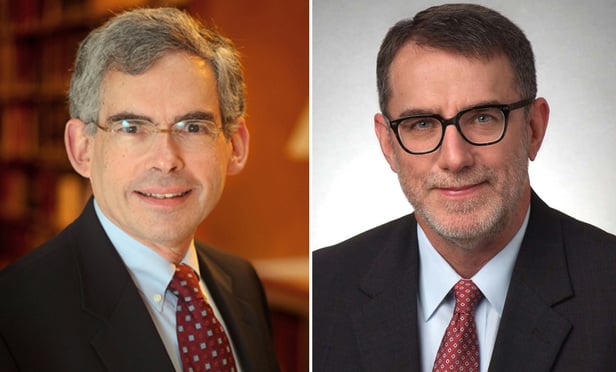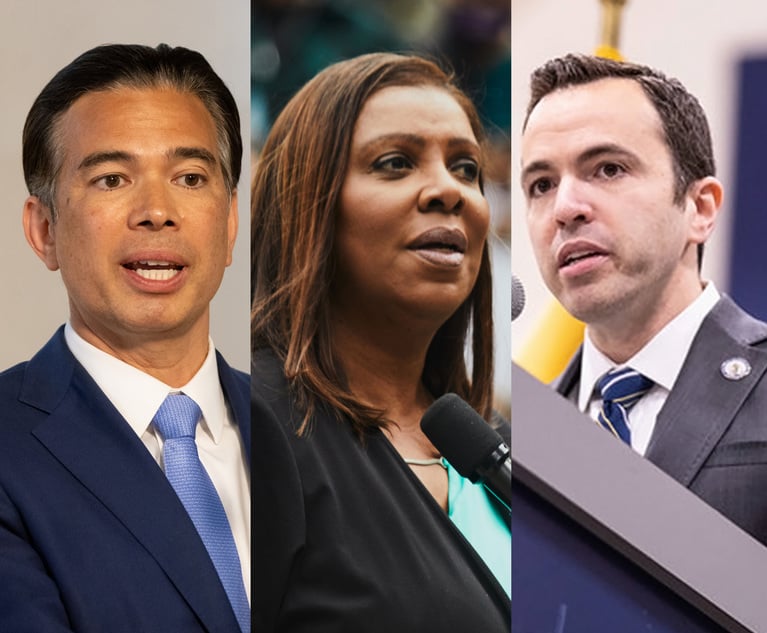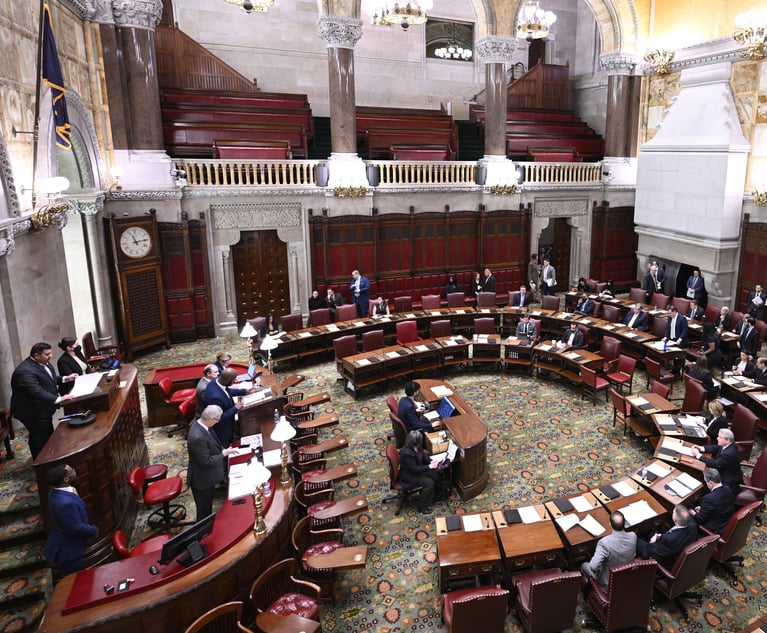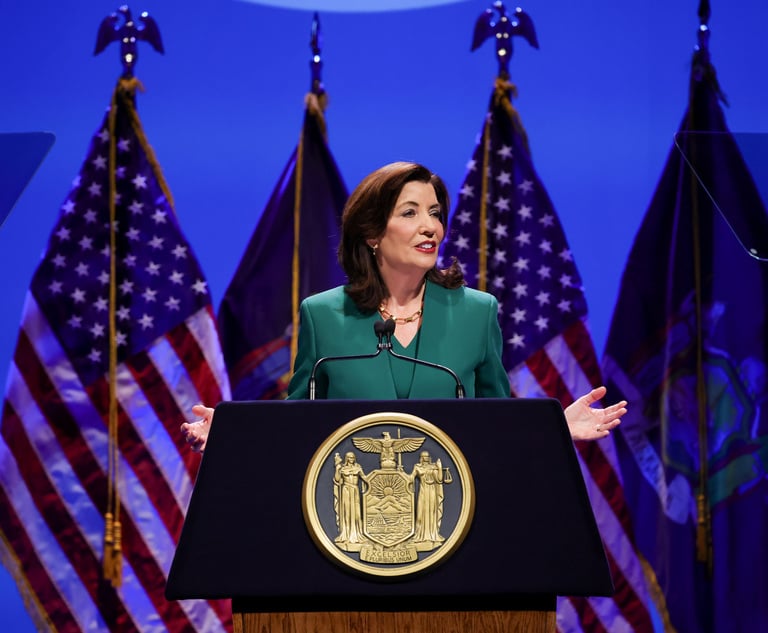New York's New Congestion Pricing Law
In their Environmental Law column, Michael B. Gerrard and Edward McTiernan discuss the “congestion pricing” policy that will be instituted in Manhattan's Central Business District in early 2021. They address what the law provides, what is yet to be decided, and who will decide.
May 08, 2019 at 12:15 PM
8 minute read
 Michael B. Gerrard and Edward McTiernan
Michael B. Gerrard and Edward McTiernan
In the biggest change in local transportation policy in a generation, maybe two, “congestion pricing” will be instituted in Manhattan's Central Business District in early 2021. It is the first action in decades that could actually lower traffic congestion, and that could provide a stable funding base for the capital program of the Metropolitan Transportation Authority (MTA). It also transfers considerable power from the Mayor to the Governor.
Vehicles entering Manhattan on or below 60th Street will need to pay a charge, probably through the E-ZPass system or, if they do not have such passes but their license plates are photographed, higher rates via “pay-by-mail.” The program has three major goals—reducing traffic volumes on Manhattan's streets by making it more expensive to drive; reducing air pollution; and providing an assured source of capital funding for the transit system.
The new program was enacted as part of the FY2020 State budget, Chapter 59 of the Laws of 2019. Most of it is codified in a new Article 44-C of the Vehicle and Traffic Law. This column discusses what the law provides, what is yet to be decided, and who will decide.
Coverage and Exemptions
Vehicles that travel south of 60th Street only on Route 9A (the West Side Highway) or the FDR Drive will not have to pay, but if they venture inward they will. The only exemptions written into the new statute are emergency vehicles, and vehicles transporting a person with disabilities (to be defined). People who reside south of 60th Street and have annual incomes below $60,000 will receive a credit against their state income taxes. Passenger vehicles will only have to pay once a day, even if they cross 60th Street more than once.
Beyond that, the board of the Triborough Bridge and Tunnel Authority (TBTA) will set the charges and decide on any exemptions or discounts. The statute directs TBTA to implement a plan for exemptions, credits or discounts for for-hire vehicles such as taxis, green cabs, black cars, and rideshare vehicles such as Uber and Lyft. Since Feb. 1, 2019 these vehicles have been paying a congestion surcharge for trips south of 96th Street of $2.75 ($2.50 for medallion taxis, $0.75 for pool trips). This surcharge was enacted by the State Legislature on April 1, 2018. Some in the taxi industry challenged the action; the New York State Supreme Court issued a temporary restraining order against the surcharge but lifted that order on January 31.
The statute also directs TBTA to consider giving breaks of some sort to drivers who already paid to enter Manhattan through one of the tolled bridges or tunnels.
The law authorizes TBTA to provide additional credits, discounts and exemptions to others, as informed by traffic studies. Among those who are already seeking breaks are motorcycle, tour bus and truck drivers, and police officers. There are conflicting press reports about whether some kind of exemption has been promised to New Jersey Governor Phil Murphy for New Jersey motorists.
A practical limit exists on how many discounts and exemptions can be granted, however, because the statute requires that the revenues from the surcharge must be enough to support at least $15 billion in bonds for the 2020-2024 capital program, which translates to an annual revenue requirement of roughly $1 billion.
The revenues must all go to capital expenditures—80% for the New York City Transit Authority (i.e., subways and buses), 10% for the Long Island Rail Road (LIRR), and 10% for the Metro North Commuter Railroad. The state budget includes a separate $100 million to design, procure and install the tolling system.
Most estimates are that the roundtrip charge will be in the $12-$14 range for passenger cars and around $25 for trucks during prime business hours, and less at night and on weekends.
Governance
The system will be planned, designed, installed and operated by TBTA, the arm of the MTA that tolls and maintains bridges and tunnels. By the end of May, the TBTA must enter into a memorandum of understanding with the New York City Department of Transportation with regard to how the congestion pricing system will be designed, installed and maintained. Unless that memorandum provides otherwise, all the key decisions will be made by the TBTA.
The law requires the TBTA to create a Traffic Mobility Review Board to conduct the traffic studies and recommend the toll amounts and variable tolling structure. One of the Board's six members is to be recommended by the Mayor of New York City. The other five members will be appointed by the TBTA (read: the Governor's Office) and are to include one member each from the LIRR and Metro North territories. The Board's recommendations are due in November or December 2020. The statute provides that the system may not start earlier than Dec. 31, 2020, followed by a phase-in period of 60 days. Given that the MTA wants to begin collecting the money as soon as possible, the system will probably debut in January 2021. The ultimate toll amounts, exemptions, and other details will be decided by the TBTA.
There is no provision for public participation in any of these decisions, except that the TBTA must hold a hearing on the proposed charges. The statute explicitly exempts the whole of the congestion pricing plan from the State Environmental Quality Review Act and the Uniform Land Use Review Procedure, two mechanisms by which public voices would normally be heard.
The law transfers a considerable amount of legal control over Manhattan streets from an agency controlled by the Mayor (the City's Department of Transportation) to one controlled by the Governor (the TBTA). Mayor Bill de Blasio evidently agreed to this switch.
History
Those seeking less traffic congestion, cleaner air and more mass transit funding have been calling for charges to enter Manhattan for many years. The Brooklyn, Manhattan, Williamsburg and Queensboro (now Edward I. Koch) bridges had tolls in the late 1800s and early 1900s, but those did not last long. City officials proposed to reinstate the tolls in 1933 but they were not enacted. In 1973 Governor Nelson Rockefeller and outgoing Mayor John Lindsay submitted to the U.S. Environmental Protection Agency a “transportation control plan” that included tolls on the free bridges across the East and Harlem Rivers. (All the other bridges and tunnels into Manhattan already had tolls.) Under the federal Clean Air Act, this plan was binding. Lindsay's successor, Mayor Abraham Beame, vigorously opposed the tolls. When the courts rejected the City's efforts to annul the plan, Congress provided relief in 1977 in exchange for pledges of more transit funding. Transit advocates repeatedly proposed new tolling plans in the ensuing years, but got nowhere.
Thirty years later, in 2007, Mayor Michael Bloomberg proposed congestion pricing, having seen the success of such a scheme in London. The plan passed the City Council and received a pledge of federal funding, but could not gain the approval of the State Legislature. Opposition from the outer boroughs and the suburban counties demonstrated once again that bridge tolls—a key element of the plan—were a third rail of New York politics.
With the emergence of electronic systems for collecting tolls without queue-generating toll booths, and with the deterioration of the transit system, the case became stronger for charging for entry into Manhattan's Central Business District and using the money to pay for transit. An additional important piece, put forward by the Move NY coalition that pressed for congestion pricing in the intervening years, was the idea of using a portion of the funding to improve transit access in so-called transit deserts—underserved parts of the outer boroughs. Governor Andrew Cuomo signaled support for the idea in 2017, and helped push it through in 2019. Mayor de Blasio came to support the proposal in the closing weeks of the state's budget process.
Congestion pricing has long worked effectively in London, Singapore and Stockholm. New York will be the first city in the western hemisphere to adopt it. The rest of the world will be watching.
Michael B. Gerrard is a professor and director of the Sabin Center for Climate Change Law at Columbia Law School, and Senior Counsel to Arnold & Porter. Edward McTiernan is a partner in Arnold & Porter, and former General Counsel of the New York State Department of Environmental Conservation.
This content has been archived. It is available through our partners, LexisNexis® and Bloomberg Law.
To view this content, please continue to their sites.
Not a Lexis Subscriber?
Subscribe Now
Not a Bloomberg Law Subscriber?
Subscribe Now
NOT FOR REPRINT
© 2025 ALM Global, LLC, All Rights Reserved. Request academic re-use from www.copyright.com. All other uses, submit a request to [email protected]. For more information visit Asset & Logo Licensing.
You Might Like
View All

Federal Judge Pauses Trump Funding Freeze as Democratic AGs Plan Suit
4 minute read
Relaxing Penalties on Discovery Noncompliance Allows Criminal Cases to Get Decided on Merit
5 minute read
Bipartisan Lawmakers to Hochul Urge Greater Student Loan Forgiveness for Public-Interest Lawyers
Trending Stories
- 1Uber Files RICO Suit Against Plaintiff-Side Firms Alleging Fraudulent Injury Claims
- 2The Law Firm Disrupted: Scrutinizing the Elephant More Than the Mouse
- 3Inherent Diminished Value Damages Unavailable to 3rd-Party Claimants, Court Says
- 4Pa. Defense Firm Sued by Client Over Ex-Eagles Player's $43.5M Med Mal Win
- 5Losses Mount at Morris Manning, but Departing Ex-Chair Stays Bullish About His Old Firm's Future
Who Got The Work
J. Brugh Lower of Gibbons has entered an appearance for industrial equipment supplier Devco Corporation in a pending trademark infringement lawsuit. The suit, accusing the defendant of selling knock-off Graco products, was filed Dec. 18 in New Jersey District Court by Rivkin Radler on behalf of Graco Inc. and Graco Minnesota. The case, assigned to U.S. District Judge Zahid N. Quraishi, is 3:24-cv-11294, Graco Inc. et al v. Devco Corporation.
Who Got The Work
Rebecca Maller-Stein and Kent A. Yalowitz of Arnold & Porter Kaye Scholer have entered their appearances for Hanaco Venture Capital and its executives, Lior Prosor and David Frankel, in a pending securities lawsuit. The action, filed on Dec. 24 in New York Southern District Court by Zell, Aron & Co. on behalf of Goldeneye Advisors, accuses the defendants of negligently and fraudulently managing the plaintiff's $1 million investment. The case, assigned to U.S. District Judge Vernon S. Broderick, is 1:24-cv-09918, Goldeneye Advisors, LLC v. Hanaco Venture Capital, Ltd. et al.
Who Got The Work
Attorneys from A&O Shearman has stepped in as defense counsel for Toronto-Dominion Bank and other defendants in a pending securities class action. The suit, filed Dec. 11 in New York Southern District Court by Bleichmar Fonti & Auld, accuses the defendants of concealing the bank's 'pervasive' deficiencies in regards to its compliance with the Bank Secrecy Act and the quality of its anti-money laundering controls. The case, assigned to U.S. District Judge Arun Subramanian, is 1:24-cv-09445, Gonzalez v. The Toronto-Dominion Bank et al.
Who Got The Work
Crown Castle International, a Pennsylvania company providing shared communications infrastructure, has turned to Luke D. Wolf of Gordon Rees Scully Mansukhani to fend off a pending breach-of-contract lawsuit. The court action, filed Nov. 25 in Michigan Eastern District Court by Hooper Hathaway PC on behalf of The Town Residences LLC, accuses Crown Castle of failing to transfer approximately $30,000 in utility payments from T-Mobile in breach of a roof-top lease and assignment agreement. The case, assigned to U.S. District Judge Susan K. Declercq, is 2:24-cv-13131, The Town Residences LLC v. T-Mobile US, Inc. et al.
Who Got The Work
Wilfred P. Coronato and Daniel M. Schwartz of McCarter & English have stepped in as defense counsel to Electrolux Home Products Inc. in a pending product liability lawsuit. The court action, filed Nov. 26 in New York Eastern District Court by Poulos Lopiccolo PC and Nagel Rice LLP on behalf of David Stern, alleges that the defendant's refrigerators’ drawers and shelving repeatedly break and fall apart within months after purchase. The case, assigned to U.S. District Judge Joan M. Azrack, is 2:24-cv-08204, Stern v. Electrolux Home Products, Inc.
Featured Firms
Law Offices of Gary Martin Hays & Associates, P.C.
(470) 294-1674
Law Offices of Mark E. Salomone
(857) 444-6468
Smith & Hassler
(713) 739-1250






